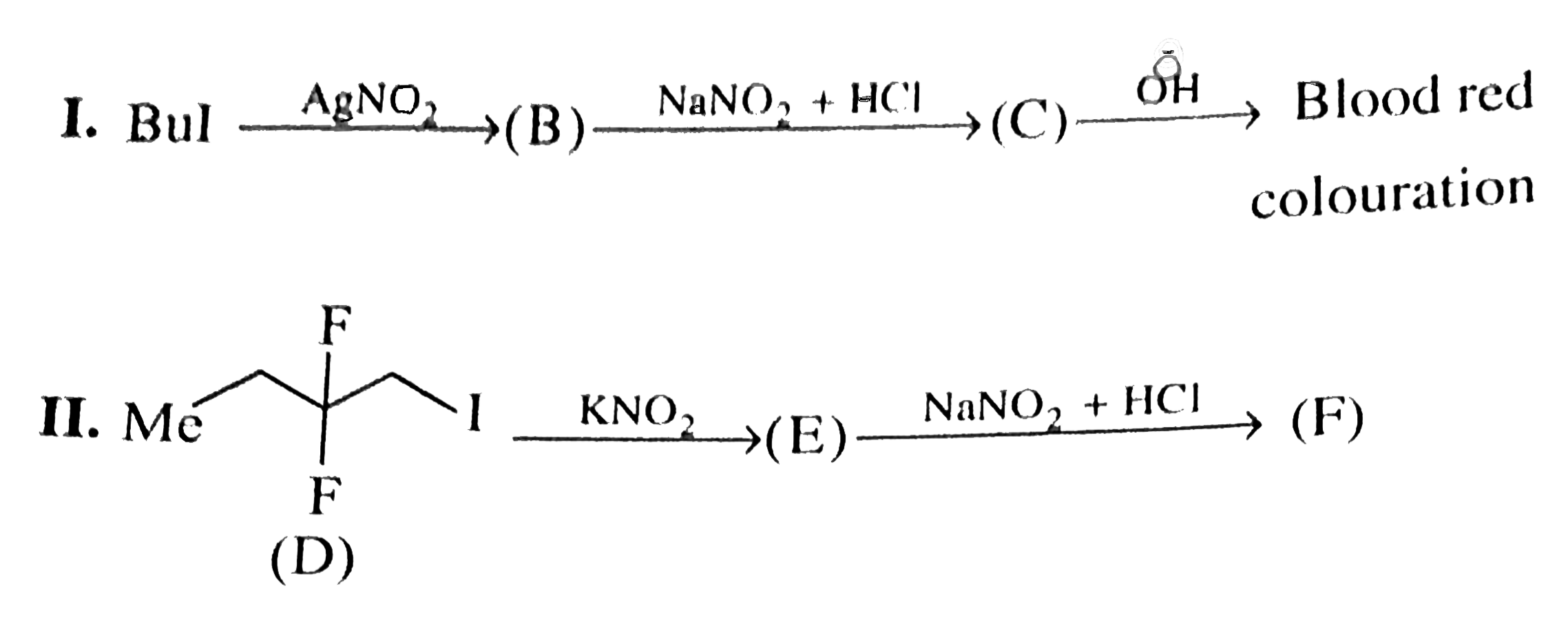
Compound (F) is:


No reaction
Both (a) and (b)
The correct Answer is:c
RX in (I) gives R−NO2 while in (II) it gives R−O−N=O
(For explanation, see Solved Example 11.10)


Topper's Solved these Questions
- AROMATIC COMPOUNDS AND ALKYL AND ARYL HALIDES BOOK - CENGAGE CHEMISTRYCHAPTER - AROMATIC COMPOUNDS AND ALKYL AND ARYL HALIDES EXERCISE - Exercises Multiple Correct
35 Videos
- AROMATIC COMPOUNDS AND ALKYL AND ARYL HALIDES BOOK - CENGAGE CHEMISTRYCHAPTER - AROMATIC COMPOUNDS AND ALKYL AND ARYL HALIDES EXERCISE - Exercises Multiple Correct Answers Type
12 Videos
- AROMATIC COMPOUNDS AND ALKYL AND ARYL HALIDES BOOK - CENGAGE CHEMISTRYCHAPTER - AROMATIC COMPOUNDS AND ALKYL AND ARYL HALIDES EXERCISE - Exercises Linked Compreshension Type
11 Videos
- APPENDIX INORGANIC VOLUME 2BOOK - CENGAGE CHEMISTRYCHAPTER - APPENDIX INORGANIC VOLUME 2EXERCISE - Short Answer Type
179 Videos
- BIOMOLECULESBOOK - CENGAGE CHEMISTRYCHAPTER - BIOMOLECULESEXERCISE - Exercises Archives (Analytical And Descriptive)
8 Videos
Similar Questions
Catalytic dehydrogenation of methyl cyclohexane, obtained from petroleum, gives a liquid which on treatment with chlorosulphonic acid at 370 K ylelds a mixture of two isomers (A) and (B), C7H7SO2CI. The major isomer (A) reacts with ammonia to form (C), which on oxidation with permanganate gives compound (D), On heating, compound (D) gives a well known sweetening agent (E). The minor isomer (B) also reacts with ammonia to give a compound (F) which on treatment with NaOCI/NaOH gives an antiseptic (G). Compound (F) on reaction with NaOCI/Cl2 (excess) and fotlowed by oxidation gives a compound (H) used for sterilising drinking water Identify (A) lo (H).
View SolutionAn organic compound (A) gives positive Liebermann's nitroso reaction and on treatment with CHCl2/KOH followed by hydrolysis gives (B) and (C). Compound (B) gives pink colour with Schiff's reagent but not (C) which is steam volatile. (C) on treatment with LiAlH4 gives (D) (C7H5O2) which on oxidation gives E. 'E' reacts with acetic anhydride and gives compound F. calculate molecular weight of 'F'.
View Solution
Knowledge Check
Four isomeric optically active compounds NaHCO3−−−−−→CO2(g)(A,B,C,D)(C4H8O3)
Compound (A)LAH−−→(E) (Archiral compound)
Compound (B)KMnO4−−−−−→orCrO3 Inert to oxidation.
Compound (C)−−−−−−−−→NaOI/H3O⊕CHI3(Yellowppt.)+Compound(F).
Compound (D) is :A(I)B(II)C(III)D(IV)Four isomeric optically active compounds NaHCO3−−−−−→CO2(g)(A,B,C,D)(C4H8O3)
Compound (A)LAH−−→(E) (Archiral compound)
Compound (B)KMnO4−−−−−→orCrO3 Inert to oxidation.
Compound (C)−−−−−−−−→NaOI/H3O⊕CHI3(Yellowppt.)+Compound(F).
Compound (A) is :A B
B C
C D
D
Four isomeric optically active compounds NaHCO3−−−−−→CO2(g)(A,B,C,D)(C4H8O3)
Compound (A)LAH−−→(E) (Archiral compound)
Compound (B)KMnO4−−−−−→orCrO3 Inert to oxidation.
Compound (C)−−−−−−−−→NaOI/H3O⊕CHI3(Yellowppt.)+Compound(F).
Compound (B) is :A(I)B(II)C(III)D(IV)
An acidic compound (A) C4H8O3 loses its optically activity on strong heating yielding (B), C4H6O2 which reacts readily with KMnO4. (B) forms a derivative (C ) with SOCl2, which on reaction with (CH3)2NH gives (D). The compound (A) on oxidation with dilute chromic acid gives an unstable compound (E) hich decarboxylates readily to give (F), C3H6O. The compound (F) gives a hydrocarbon (G) on treatment with amalgamated Zn and HCl. Give the structures of (A) to (G) with proper reasoning.
View SolutionAn acidic compound (A)(C4H8O3) loses its optical activity on strong heating yielding (B)(C4H6O2) which reacts readly with KMnO4. (B) forms a dervative (C) with SOCl2 which on reaction with (CH3)2NH gives (D). The compound (A) on oxidation with dilute chromic acid gives an unstable compound (E) which decarboxylates readily to give (F)(C3H6O). The compound (F) gives a hydrocarbon (G) on treatment with amalgamated Zn and HCl. Give the structures of (A) to (G) with proper reasoning.
View SolutionCompound (E) when treated with KCl gives an orange red compound (F) which is used as an oxidising reagents.
View SolutionCompound (x)(m.f=C7H8N), on reaction with NaNO2 and conc. HCl at O∘C followed by β− naphthol gives orange coloured dye. Compound (x) is :
View SolutionFour isomeric optically active compounds NaHCO3−−−−−→CO2(g)(A,B,C,D)(C4H8O3)
Compound (A)LAH−−→(E) (Archiral compound)
Compound (B)KMnO4−−−−−→orCrO3 Inert to oxidation.
Compound (C)−−−−−−−−→NaOI/H3O⊕CHI3(Yellowppt.)+Compound(F).
Compound (C) is :
View Solution
